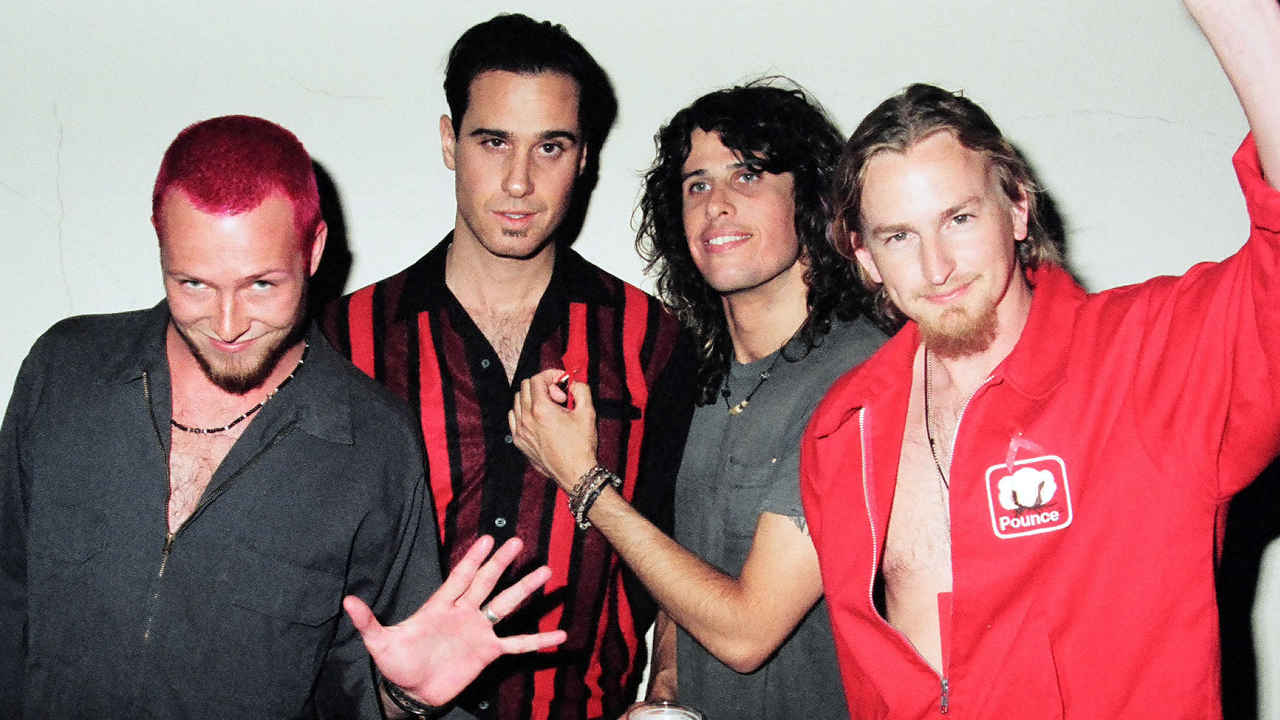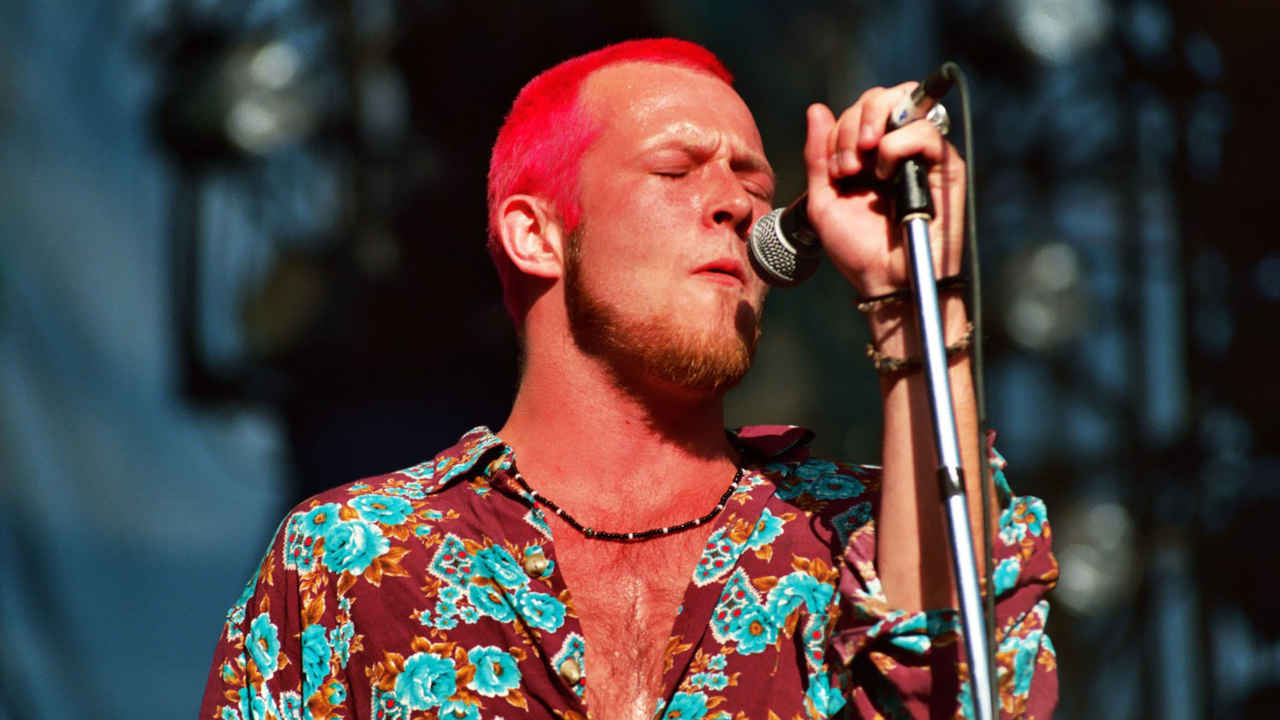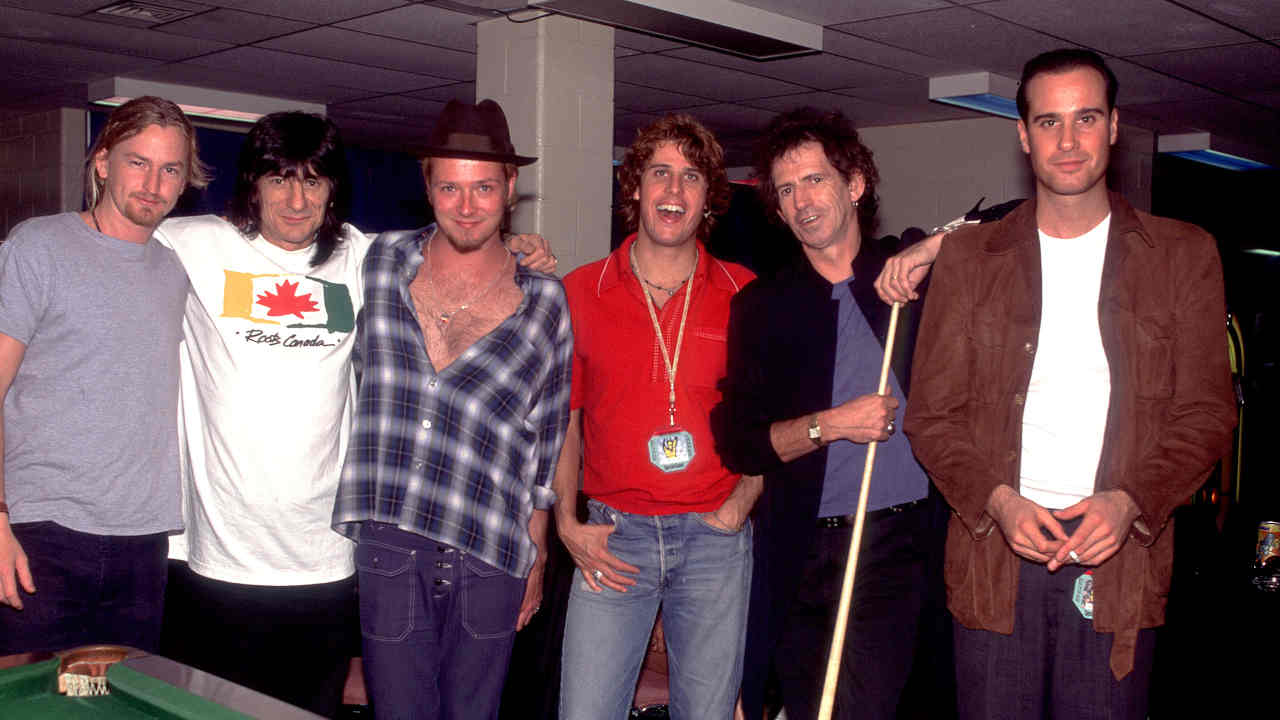
As Stone Temple Pilots were approaching making their second album, their A&R man Tom Carolan pulled the band aside and offered four simple words of advice: “Fasten your seat belts.” It’s a line that their bassist Robert DeLeo has repeated when working with young artists on the cusp of their own breakthrough. “It’s a ride that sometimes you’re not going to be able to control,” he says.
He should know. By the time they were getting ready to make that second album, Stone Temple Pilots were already aboard the roller-coaster and picking up speed rapidly. Their 1992 debut album Core had made them the latest grunge rockers to break big, but many peers and critics viewed frontman Scott Weiland, drummer Eric Kretz, Robert and his guitarist brother Dean with suspicion. They were the men apart in a grunge clique based predominantly 1,000 miles north in Seattle.
In Weiland they had a showman singer whose voice could morph from a raspy, Eddie Vedder-esque growl to smooth, Layne Staley-style crooning, sometimes in the same verse. Their music injected classic-rock riffs with glam stomps here, a breezy Americana twang there, and a punky theatricality over the top. It was almost as if the band realised that rock music didn’t have to just stare at its shoes, it could be entertaining too.
As it happens, they were having so much fun touring Core that they barely noticed the disdainful looks being cast their way.
“Core was a really lovely experience,” recalls Dean who, like Robert, is speaking from his home in Southern California. “It was when we first met [producer] Brendan O’Brien, and he had us all living in a house about two or three miles from the studio. He didn’t want us toiling around in LA traffic, he wanted us to be timely. Brendan is very timely, and he gets bored easily.”
O’Brien’s restlessness would become essential in what made Purple, the follow-up to Core, the band’s defining record; an album that captured what made STP such a thrilling rock band. But it would never be the same again for them, with Weiland’s well-documented substance abuse overshadowing subsequent recordings. Purple is where everything clicked, where they channelled the heady momentum of a triumphant debut into something more ambitious and daring.
There was certainly no sense of complacency creeping in as Core’s sales figures grew and the band embarked on a lengthy US tour. They had the wind in their sails. “Touring Core, there was a lot of material floating around already,” says Dean. “Core was doing what the mighty Atlantic Records had hoped for, but they really wanted to take Plush, our second single off Core, for all it was worth. We didn’t know if that was a good idea, we just wanted to move on and release another single.”
The band’s reaction to their label attempting to draw out Plush’s success was to get into the studio and lay down something new. “We stopped off at Paisley Park [Prince’s studio in Minneapolis] for a few days, and Brendan flew out, and we recorded Lounge Fly,” says Dean.
That was in the summer of 1993, almost a year before they would record the rest of what would become Purple, but a marker had been put down: in Lounge Fly’s backwards-guitar loops, labyrinthine production, rhythmic interplay and surging chorus, they’d laid down a sonic blueprint that pushed things forward. The label might have been hankering for Core Part 2, but the band had other ideas.
“Atlantic definitely wanted that,” says Robert. “But we knew we didn’t want to be here today, gone tomorrow, trying to recreate Core. It was a band decision. We knew we had a pretty good outline and a good road map of where we wanted each song to go. It’s what propelled us forward, to get in there and make something new, making something that was moving forward.”
Confidence could be drawn from the fact that they knew they already had some aces in the pack. Two months before entering Paisley Park, they had gone into the Record Plant studios in LA to record a song for the soundtrack to The Crow, the gothic action film starring Brandon Lee as an avenging anti-hero. The resulting Big Empty, an eerie, slo-mo bluesy number that explodes into life with a yearning, epic chorus, was a dramatic leap forward from anything on Core. In addition to that, Dean also knew that his brother was sitting on something equally remarkable.
“A defining moment for me that we were well on our way for a second record is when we’d spent a night in Atlanta in a dodgy hotel and we were just getting ready to leave,” he recalls. “We were out in the parking lot, and Robert had an acoustic guitar and we were sitting on the bumper of our Ryder truck that we were renting, and he goes: ‘Check out this idea I have,’ and he played Interstate Love Song on the guitar and whistled the melody. I remember it vividly. I was really taken aback. I remember knowing deeply that it was a very special song.”
Dean also had the idea that an instrumental they had once opened live shows with could be fashioned into something more fully formed. Based on a repetitive, hammering riff, it would become Vasoline, eventually Purple’s calling card.
“It had a few different parts, and when we were doing it as an instrumental it had elements of the bridge in Sin from Core,” says Dean. “There was a real amalgamation of material floating around. When we got into pre-production for Purple we were sitting on a lot.”

After spending most of 1993 on the road, the band began ’94 by locking themselves in a rehearsal space in LA to nail down songs and arrangements before heading down to Atlanta for pre-production sessions with O’Brien. A week later, recording began at Southern Tracks on the outskirts of the city.
“We really honed in on the songs with Brendan and made them very concise,” says Dean. “It was about getting really prepared. This is 1994, in the lap of when studios were very expensive, man. We were very well-rehearsed and we approached the records in a live situation.”
Prepping to enter the studio, Robert remembers feeling the pinch of pressure before gathering himself. “For a moment there, I thought: ‘I need to come up with another Plush. It lasted for a little bit, and then I realised it wasn’t what I wanted to get out of the second record. I felt pretty confident when I wrote Interstate… that it was going to be something I believed in. Everybody’s contribution to the record was moving in a direction where it was building more and more confidence in what we were doing.”
Key to the band’s sense of ease was working with O’Brien again. The producer was on his way up when he took his place behind the mixing desk for Core, but had sealed his reputation in the intervening years, becoming the go-to guy for grunge titans including Pearl Jam and Soundgarden.
“Brendan’s studio was like a candy store, all this real beautiful vintage gear that we’d always dreamed of,” say Robert. “There were so many things in there to pick up and grab. It definitely helped with the sonic colour of the songs.”
While the DeLeo brothers and Kretz were getting to grips with Purple’s sound palette, Weiland would skirt on the edges, putting down guide vocals here and there, but internalising his lyric writing until push came to shove.
“Scott’s presence was: ‘Let these guys work it out, and then I’ll come in,’” says Dean. “When he needed to be around, he was around. When he didn’t need to be around, he wasn’t. Scott was actually the youngest cat in the band, and life was changing fast,” he continues. “He had a lot to say about that. Our lives were changing at a rapid rate. It was a learning curve.”
When the backing tracks were ready for him, the band would have dinner together and Weiland would head back into the studio with O’Brien to put down his vocals.
“Man, when they wrapped that up at say ten or eleven o’clock at night, we would go in and sit down and have a listen,” says Dean. “To have the luxury of Mr. Weiland sing on your song was a huge pay-off. It was very rewarding. It was wonderful. Scott always hit the mark on making a song what it should be. A great lyricist, almost a poet. It was something that we heard from Brendan, that Scott was an easy singer to record. He presented it. Not everyone can do that. It was just natural for him to get on a mic and make it happen.”
Trawl through any of the interviews that Stone Temple Pilots gave following Purple’s June ’94 release and there are rumblings of there being disquiet during the recording sessions. “Purple almost didn’t get done,” Robert told Rolling Stone in 1997. “It ended up with Dean, Eric and myself and Brendan sitting in a room, saying: ‘Do we pack this up?’” In 1994 Weiland told Headbanger’s Ball: “If we couldn’t be the best of friends, we knew we had to make it for our own selfish purposes.”
Looking back now, though, the DeLeo brothers see it as nothing more than young men’s angst. “We were probably all sick of each other at point, after fourteen months on the road,” Robert says with a laugh.
In the wake of Weiland’s death from accidental overdose in 2015, it’s perhaps understandable that they’ve let any agitation around the period dissipate, honing in on the positives instead.
“Man, we were very much aligned with one another and it was a wonderful time,” offers Dean.
When Robert thinks back to his favourite moments making Purple, rather than something musical that springs to mind it’s all the larking about they did together. “There was a basketball court out in the parking lot and we played wiffle-ball or basketball. That was the time we’d all bond and get our minds off what we were doing, because you can get pretty deep inside yourself. We were still trying to work things out in our twenties.”
Amazingly, Purple was recorded, mixed and mastered in three weeks. “It’s the way Brendan works. It leaves no room for second-guessing things. That’s what kept it very real and lively,” says Robert. “We literally tracked it live with a PA system, because Brendan wanted the livest feel from the songs, and that’s what we got.”
Purple is the sound of a band operating at their adventurous peak. Out of all those great rock records that came out in the first five years of the 90s, not many sound better the further down the line you get from it in the way that Purple does. Some of those albums are brilliant precisely because they are wedded to that era, but something about Purple is better floating out of time. It could be the sheer sense of exuberance in the music. Or that feeling of a lyricist giving his words both an emotional depth and a swagger. Or maybe it’s just because the brilliance of this record at the time was tainted by so many being a bit snooty towards Stone Temple Pilots for reasons that seem quite ludicrous now. It was an era when the Authenticity Police were on patrol, and perhaps STP were pulled over for looking like they were having too much of a good time.
“I wasn’t making records for those people, I was making records for myself, to make myself happy or pleased with my writing,” Robert says with a shrug. “I knew what we were doing, and I think it went over people’s heads musically. There’s some very complex stuff on there, and I think you have to be a musician to somewhat understand, and a lot of people didn’t. I get a lot of compliments from musicians to this day on how beautiful these chords work together – and I can see on YouTube that a lot of people haven’t quite figured them out yet.”

Released on June 7, 1994, Purple entered the US Billboard chart at No.1 and went Top 10 in the UK. It sold 252,000 copies in its first week, and after four months had sold three million. That was all the validation that Dean DeLeo needed.
“We were our own worst critic,” he says. “That’s what resonated with so many listeners, because we had to be satisfied and moved from it.”
The guitarist says that in the aftermath of its release he had calls from fellow musicians big at the time to offer their congratulations, but he won’t reveal who. “It was everybody releasing records at the same time,” he says. “They’d heard Vasoline, and they called me, like: ‘Lord, god!’ They did the same when Big Bang Baby [from 1996’s Tiny Music… Songs From The Vatican Gift Shop] came out a few years later.”
By that point, though, the band’s state of affairs had worsened considerably, with Weiland’s drug use introducing a sense of turbulence and chaos into recording sessions. “Purple was a much easier ride,” says Robert, considering whether this was the last era of the band before things got messy. “Yes, yes,” he says. It’s a sign of how everything for the band got derailed after the release of Purple almost three decades ago that Stone Temple Pilots, now fronted by Jeff Gutt, have played in the UK only a handful of times.
But the sense of accomplishment he felt upon leaving the studio having completed Purple has never dimmed for Dean DeLeo. When he plays those songs live now, he’s flooded with memories of Scott Weiland. “It’s very emotional,” he says, his voice cracking ever so slightly. “I’m just feeling him. There’s times when I can just smile and laugh, and there’s times it brings me to tears, man.”
“Hearing these songs now makes me miss him more,” says Robert. “It really has proven how long and lasting what he put on these songs are. It’s a shame he’s not here to enjoy it. He should be part of this interview. It’s sad to see the path he took.”
“I wish I could change things to where Scott was here,” says Dean. “If I had a magic wand I’d make changes there. I’d make sure he was here and you could talk to him yourself.”







